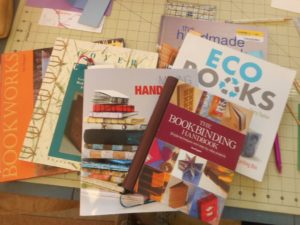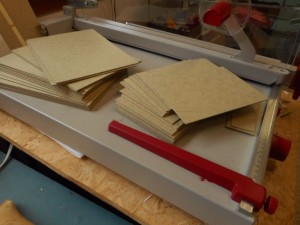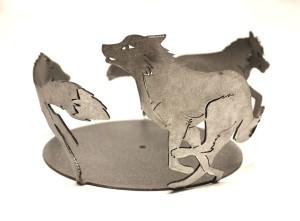A few weeks ago I had lunch with a friend who is a painter and she told me about a challenge she was presenting to our local Art Guild – 30 paintings in 30 days. The object is to get into the studio every day and do a small, fast painting in just an hour or so. Painters, like many of us, have a tendency to put off working because of the tremendous amount of creative energy and effort required for a finished work. This challenge stimulates creativity by putting it into small, manageable bits and allows the artist to try lots of different approaches.
I was intrigued by the project, but my first reaction was I couldn’t possibly do that with books. An hour was barely enough time to cut and fold paper or sew the endbands. This is especially true of the complex books I’ve been playing with recently – elaborate sewing structures that aren’t even seen, hand-sewn endbands, leather covers with metal inserts or tooling.
The idea clung to the back of my mind and one day I happened to move a pile of bookbinding books.  I’d been disappointed in most of these books as they focused on the flippy-floppy, origami type books or very simple structures that are primarily a vehicle for artist content. I’m just not a content person. I’m much more interested in the structure. It suddenly clicked and I realized that these were just the types of structures that were perfect for the challenge and thus began my odyssey into 30 in 30. I’m not being completely literal on this. I’ve had to take a few days off for things like repairing the pump in the well and tearing out my garden. I’ve also found that some of these books take more than one day to complete. I have decided that those books can count as two days, because while a half-finished painting can still inspire, a half-finished book is just a pile of folded paper and odds and ends of card stock.
I’d been disappointed in most of these books as they focused on the flippy-floppy, origami type books or very simple structures that are primarily a vehicle for artist content. I’m just not a content person. I’m much more interested in the structure. It suddenly clicked and I realized that these were just the types of structures that were perfect for the challenge and thus began my odyssey into 30 in 30. I’m not being completely literal on this. I’ve had to take a few days off for things like repairing the pump in the well and tearing out my garden. I’ve also found that some of these books take more than one day to complete. I have decided that those books can count as two days, because while a half-finished painting can still inspire, a half-finished book is just a pile of folded paper and odds and ends of card stock.
So here goes: The first 5 days.
Day 1 The X Book, from Golden 100 Books.
- First attempt
- Whoops, cut fold.
- Added pages
- Unfolded with pages
- Day 1 results
- Source Book
I would call this more origami than book, but it did get me started. After folding the red book, I wasn’t happy that the edges weren’t even, so I trimmed the fore edge. That looked better, so I trimmed the head and tail forgetting that the fold at the head was what held the book together. Whoops! On the blue piece, I felt my usual frustration at just having a folded piece of paper, not a book. Then I realized that I could sew pages into the interior folds. These pages are not in the original instructions. If I wanted to go even farther, I could glue the backs of the cover paper to make a more stable structure.
Day 2 The X Book with pockets
- Second try w/ scrap
- Day 2 Final Book
- Pockets
- Pockets with stuff
- Source Book
This is just a variation on Day 1. An extra piece is folded to create a pocket and placed inside the cover paper. One problem for me was that the pocket paper shows both sides and I used a one-sided paper. If you look closely you can see that the pocket has a design and the back above it is plain (the other side of the paper). So my marbled paper isn’t suitable for the pockets.
Day 3. Brush Book
- Day 3 Brush Book
- Day 3 Brush Book
- Where Am I?
- Source Book
This is a cute little idea for people who have content. I just used pieces of maps that I had marbled. It is just folded with no sewing or glue, making structure not very solid. A stronger paper for the spine might have helped.
Day 4. Stick Binding
- Day 4 Stick Binding
- Open
- Top
- Back
- Source Book
I finally got to sew on this book! Very simple structure, but cute using a twig to hold the sewing thread. I used a paper with heavy inclusions and am pleased with the result. The book does violate one of my cardinal rules that books I make must be able to be shelved without damaging themselves or the books next to them. I dislike dingle-dangles and stick-ons that are not properly inlaid.
Day 5. Pamphlet Book
- Pam bound book
- Endpapers
- Single Section
This is a bit of a cheat as it is a small book that was a special order from Etsy. I decided that it counted anyway.
Note: I am currently working on Day 12, but wanted to get my blog started. I hope to update the next five books in the next few days and maybe catch up to date.






























































































 I asked Sam what he was going to do with the unusable rings and he wasn’t sure. Three days later I suddenly realized that the foxes were just the right size for some of my boxes and books, so I asked Sam if he were willing to snip some off and let me play with them. He did and this is the rest of the story.
I asked Sam what he was going to do with the unusable rings and he wasn’t sure. Three days later I suddenly realized that the foxes were just the right size for some of my boxes and books, so I asked Sam if he were willing to snip some off and let me play with them. He did and this is the rest of the story.





















































































































































































